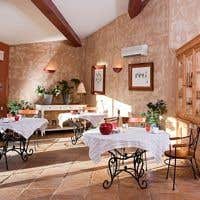This article was also published in the Financial Times.
As we drove the final four kilometres up the steep road that leads to the Auberge du Vieux Puits in the small village of Fontjoncouse in the rugged Corbières mountains of south-west France, little seemed to have changed since our first visit 15 years ago.
La garrigue, the local name for the scrub in this part of the Mediterranean that is so redolent of rosemary and thyme, stretched out on either side; the sun played hide and seek behind the mountains; and the cicadas sang loudly.
A string of carefully tended vegetable plots marked the entrance to the village. Then, directly under the plane trees and at precisely 7.15 pm, a sight unfolded that is common to all those small towns and villages across France where a highly regarded restaurant is the main employer.
Rather like a call to prayer, or even to arms in a bygone era, people were striding out on to the main road. There were young girls in red jackets, members of the housekeeping team; waiters and waitresses bustling along putting on their uniforms before the first customers arrived; and several young cooks somewhat more languidly enjoying their last moments in the fresh air before the heat of the kitchen. As I drove round the back of the restaurant I noticed one of their colleagues who had obviously drawn the short straw hastily cleaning the restaurant's windows.
Once inside, however, it is obvious that a great deal has changed since Gilles and Marie-Christine Goujon took over this restaurant just over 20 years ago for a trifling sum.
L'Auberge du Vieux Puits now boasts 14 comfortable bedrooms; the kitchen has garnered the maximum three Michelin stars; and Goujon himself has found time to become a Meilleur Ouvrier de France, passing the most strenuous practical examination any French chef can subject himself to. Collectively, the Goujons have also generated a great many jobs in a region where the more traditional employers, agriculture and viticulture, are in decline.
At midnight, as we left the restaurant and stood under a starry sky, Goujon confessed that his journey has been something of a struggle (it must be wild up here in the long winter) but he has never lost his very obvious joie de vivre. In fact, I don't think I have ever encountered such an apparently happy chef as Gilles Goujon. He beamed with pleasure and pride as we walked into his restaurant. Such was his concern for the fourth member of our party (incidentally the best cook), who had been laid low on the drive up and spent the evening in her bedroom, that he almost ran over to our table as we sat down offering vegetable bouillon and any other elixir at his kitchen's disposal. And when we left he was genuinely delighted to hear that we had eaten well.
Which we had, albeit with reservations. The first, and the more intangible, is that once any restaurant has achieved such a high professional rating, how does it compare with its peers? The second is far more basic: is the hospitality, the level of service, equal to that of the kitchen?
It was the service not the food that was disappointing. While the young waiting staff buzzed around the restaurant enthusiastically, there seemed to be a lack of communication at the upper echelons. We were asked on two separate occasions whether we would like to order our meal; our requests for water never bore fruit; and of course, this being haute cuisine in France, there were far too many unnecessary interruptions.
Perhaps one reason why Goujon retains such a sunny disposition is that he takes such a straightforward approach to writing his menu. The à la carte menu offers just three choices of starter, fish and meat main course and four desserts, on top of which there is only a 175 euro surprise menu and, at 145 euros, a menu entitled 'quelques pas dans la garrigue', a few steps in the surrounding countryside, which we all chose.
Our menu began close to home with a particularly appetising essence of gazpacho from local tomatoes, but then took off down the eastern coast of Spain to Palamós, source of excellent red prawns. We were served one whole one each, expertly peeled and cooked sitting inside a 'bracelet' of thin, crisp black rings of potato combined with squid ink. This was excellent despite the unnecessary addition of a smoked ham foam.
We then travelled west to Guadeloupe for a mild version of 'sauce chien' or 'dog sauce' with a fillet of turbot and then south to Morocco for a rendition of pigeon, apricots and a well-crafted pastilla. Our champagne aperitif was excellent value, a bottle of non-vintage Chartogne-Taillet's Cuvée Sainte-Anne (80 euros) ordered in an altruistic but ultimately vain attempt to restore our friend's appetite. The three of us then shared a stunning bottle of Château de Fonsalette 2001 red from the southern Rhône (187 euros).
The surrounding countryside provided one the best cheese trolleys I have ever enjoyed, over 50 from cow, goat and ewe's milk and various combinations thereof. Goujon also shows off the best local producers at breakfast with their honey, jams and an excellent cherry juice from Domaine de Bellevue in Campagne-sur-Aude.
I left Fontjoncouse with two vivid memories: of a restaurant deeply rooted in its 'terroir', its surrounding countryside, and of a resolute, and happy, chef.
Auberge du Vieux Puits, 11360 Fontjoncouse, France; tel +33 4 68 44 0737
The photo is taken from the restaurant's website.

